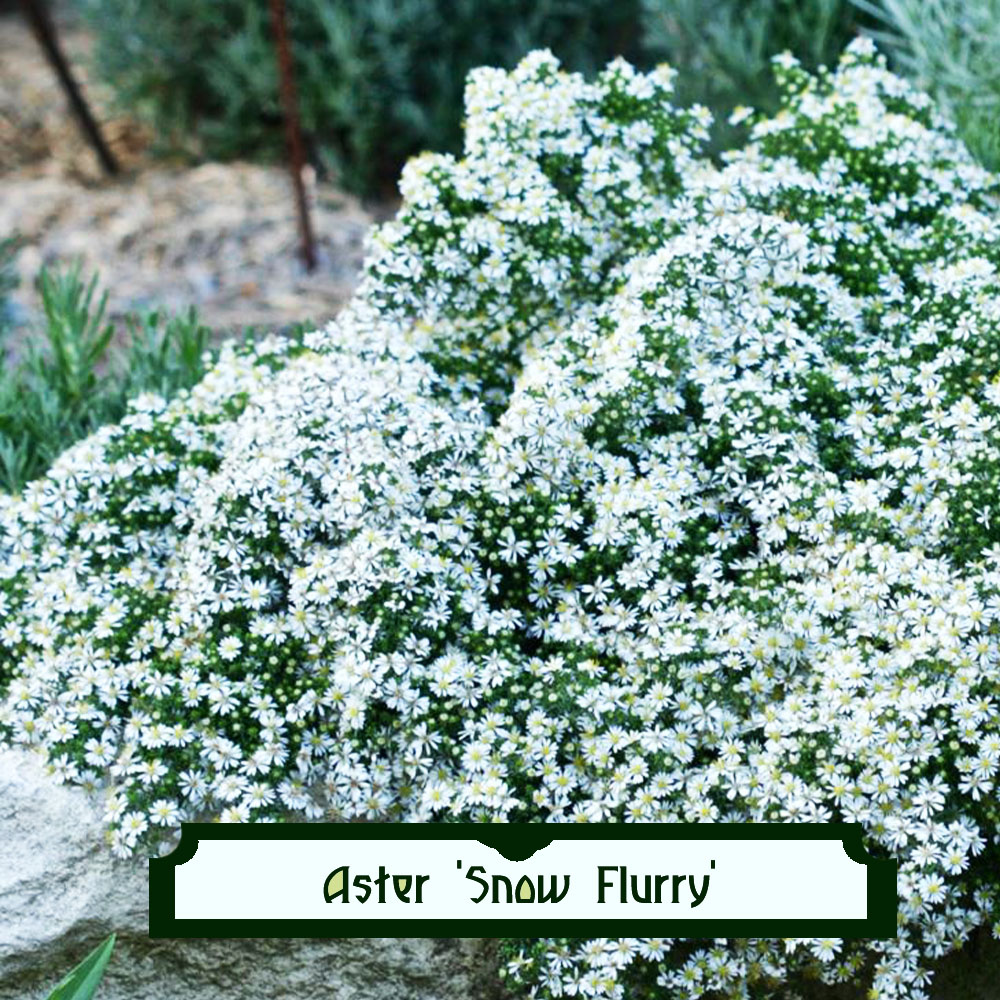No products in the cart.
Symphyotrichum ericoides f. prostratum ‘Snow Flurry’
Large airy ground cover of brilliant white flowers.
Rated 0 out of 5
0 customer reviews
4,90 €
Only 23 item(s) left in stock!
Tags: chaud, couleur, graphique, perennial, plant, potted plant, secheresse, soleil, vivace, vivace en pot, xeriscaping
SKU: pda483
Category: Bees and Butterflies, Balcony-Friendly, Bouquet, Frost Hardy, Ground Cover, Rewild

Symphyotrichum ericoides f. prostratum 'Snow Flurry'
4,90 €
Only 23 item(s) left in stock!
Symphyotrichum ericoides f. prostratum ‘Snow Flurry’ forms a prostrate clump of dark green foliage and sparkling white flowers.
At first glance it resembles a spreading dwarf juniper as the stems are sprawling and rigid to the touch.
The leaves are notably linear and relatively stiff.
The flowers appear in late summer/mid-autumn and take the form of white, star-shaped blooms with a yellow center, covering the entire plant when in full bloom.
This plant is ideal for the front of the perennial border and is an excellent candidate for the rock garden.
It makes an excellent companion for early flowering perennials, like fire pink (Silene coronaria) or golden columbine (Aquilegia ‘Leprechaun Gold’).
The blooming period is long and highly attractive to pollinators.
👨🌾GARDENING TIPS👨🌾:
-
- ☀️Prefers full sun and dry, well-drained soil.
- 💧Applying mulch around the clump will help retain moisture for a longer period.
- ✂️ Cutting back the stems to 20cm from the ground in January promotes a strong reconstitution
- ➗Divide the clumps as they begin to multiply. It isn’t invasive, but can be a vigorous grower.
- Continue learning about Asters:
-
>> RHS Tips on Gardening with Asters (In English)
-
>> Most Beautiful Asters by Le Parisien (In French)
-
The Tales & The Botany:
Formerly known as Aster ericoides f. prostratus ‘Snow Flurry’.
The name Aster comes from the Ancient Greek word ἀστήρ (astḗr) which means ‘star’ – we’ll assume that it refers to the shape of the flower head.
The genus used to encompass over 600 species, but various studies showed that the families of North America are actually a different kettle of fish. Today, the Aster family encompasses around 170 species, all but one of which are restricted to Eurasia.
It is one of the few flowers that blooms in fall – specifically during Michaelmas (29 September) – which is why there is even a rhyme in its honor!
-
- “The Michaelmas daisies, among dead weeds, Bloom for St Michael’s valorous deeds”
🌸Floral morphology
- It is characteristic of the Asteraceae family: the flowers are arranged in composite heads (capitula), combining central disk florets and peripheral ray florets.
The ray florets are usually brightly colored—shades of purple, blue, pink, or white—while the disk florets are often yellow, providing a striking contrast. Each capitulum is subtended by bracts (phyllaries) forming an involucre. Flowering occurs from late summer to autumn in most species, making asters important for late-season garden color.
🧬Reproductive biology
Asters are hermaphroditic, pollinated primarily by insects such as bees, butterflies, and beetles. Many species readily self-seed and can naturalize in favorable conditions. Seeds are small achenes, often with a pappus that aids in wind dispersal.
🦋 Ecology & cultivation
Asters thrive in well-drained soils with moderate fertility and require full sun to partial shade. They are generally hardy, tolerating frost and varying moisture conditions. Asters are valued for ornamental gardening, pollinator support, and their role in naturalized meadows and prairie restorations.
Other Names:
Michaelmas daisy
Origin:
North America
| Weight | 0,5 kg |
|---|---|
| Flower Color | ⚪ White |
| Flowering | August, September, October |
| Soil | Dry, Well-Draining |
| Exposure | Full Sun |
| Frost Tolerance | -15°C to -20°C |
| Size | 0.3m H x 0.5m W |
Reviews
0
Rated 0 out of 5
0 customer reviews
5
0
4
0
3
0
2
0
1
0
Only logged in customers who have purchased this product may leave a review.
Related Products
Euphorbia cyparissias Clarice Howard
A Euphorbia that resembles a soft little cyprus tree
A Euphorbia that resembles a soft little cyprus tree
Rated 0 out of 5
Erigeron kavinskianus
A daisy-like carpet of flowers
A daisy-like carpet of flowers
Rated 0 out of 5
Kalanchoe daigremontiana
A toothy succulent from Madagascar, known as the Mother of Thousands.
A toothy succulent from Madagascar, known as the Mother of Thousands.
Rated 0 out of 5
Glechoma hederacea
A sweet smelling ground cover, producing little blue flowers all summer long.
A sweet smelling ground cover, producing little blue flowers all summer long.
Rated 0 out of 5
Tanacetum densum subsp amani
A shrublet composed of soft, finely divided silvery gray-white leaves.
A shrublet composed of soft, finely divided silvery gray-white leaves.
Rated 0 out of 5
Hieracium maculatum Leopard
A native perennial with blue-green leaves and a tall yellow flower
A native perennial with blue-green leaves and a tall yellow flower
Rated 0 out of 5
Echinacea purpurea
A perennial with purple flowers all summer long
A perennial with purple flowers all summer long
Rated 0 out of 5
Artemisia Valerie Finnis
A semi-evergreen, aromatic variation on the theme of Artemisia.
A semi-evergreen, aromatic variation on the theme of Artemisia.
Rated 0 out of 5
Hellebore argutifolius
Winter flowering perennial with marbled blue-green leaves
Winter flowering perennial with marbled blue-green leaves
Rated 0 out of 5
Melissa officinalis
A perennial plant in the mint family that is adored by bees, royal families and tea drinkers.
A perennial plant in the mint family that is adored by bees, royal families and tea drinkers.
Rated 0 out of 5
Trachelospermum asiaticum ‘Ogon Nishiki’
Jasmine with colorful foliage and lovely white flowers in summer
Jasmine with colorful foliage and lovely white flowers in summer
Rated 0 out of 5
Delosperma cooperi
A dwarf perennial known for its vermillion colored flowers
A dwarf perennial known for its vermillion colored flowers
Rated 0 out of 5
Vinca minor
Looping elegance and ability to form a low flowering ground cover
Looping elegance and ability to form a low flowering ground cover
Rated 0 out of 5
Cerastium tomentosum var. columnae
A grey-green spreading ground cover from the mountains.
A grey-green spreading ground cover from the mountains.
Rated 0 out of 5
Mentha x piperita ‘Chartreuse’
A spicy mint, known for its use in the production of liqueurs and herbal teas.
A spicy mint, known for its use in the production of liqueurs and herbal teas.
Rated 0 out of 5
Stachys byzantina
Silky white-grey leaves and tall striking flowers
Silky white-grey leaves and tall striking flowers
Rated 0 out of 5
Sedum album
A low, multi-color ground cover.
A low, multi-color ground cover.
Rated 0 out of 5
Euphorbia myrsinites
Known for its draping form of silver-gray foliage and radiant blooms.
Known for its draping form of silver-gray foliage and radiant blooms.
Rated 0 out of 5
recent view product
Nepeta clarkei
Catnip from the mountains of Pakistan and India
Catnip from the mountains of Pakistan and India
Rated 0 out of 5
Tradescantia pallida
Pale mauve-green leaves and stems edged with a fine purple line
Pale mauve-green leaves and stems edged with a fine purple line
Rated 0 out of 5
Aster novi-belgii ‘Henri Picot’
Large clouds of bright blue flowers.
Large clouds of bright blue flowers.
Rated 0 out of 5
Rosmarinus officinalis ‘Repens’
A cascading variation on the classic Mediterranean rosemary.
A cascading variation on the classic Mediterranean rosemary.
Rated 0 out of 5
Galium odoratum
A fragrant ground cover with a unique shape
A fragrant ground cover with a unique shape
Rated 0 out of 5














































There are no reviews yet.